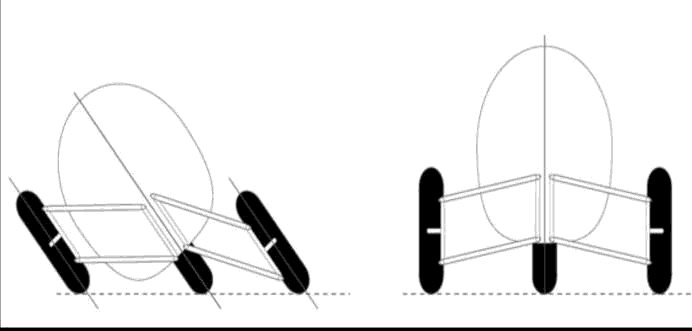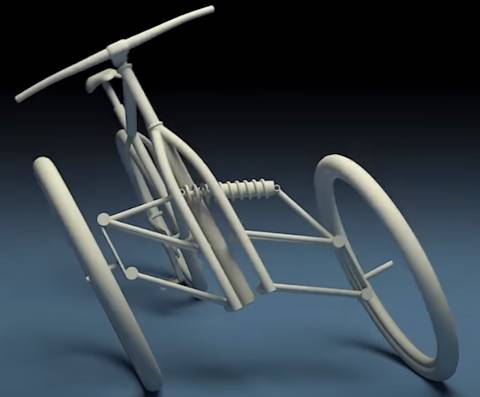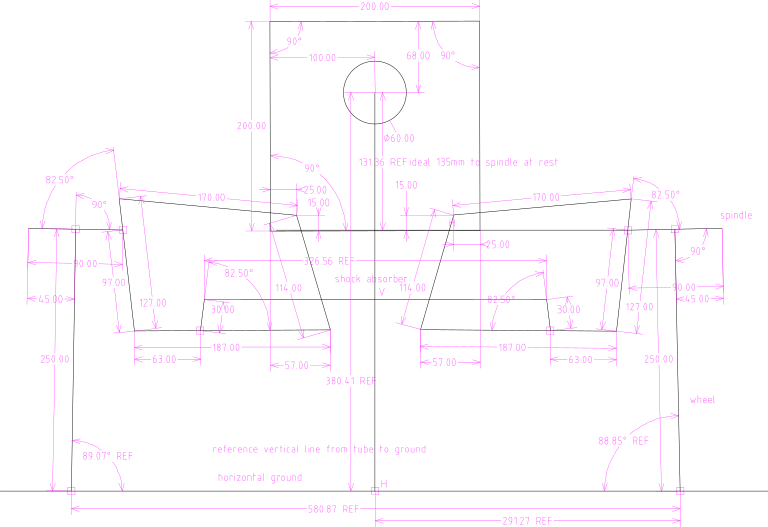Design of front suspension for leaning recumbent trike
I posted yesterday about preliminary design of front suspension for a tadpole recumbent trike:
https://bkhome.org/news/202310/design-of-front-suspension-for-recumbent-tadpole-trike.html
I wasn't going to, but then thought, hey, why not go the whole way, and make it a leaning trike?
In yesterday's post, I did say that the rider can lean into a corner.
This is, however, fighting against both the strong shock-absorbers and
the momentum that is throwing the rider outward. The result is that the
rider might not be able to achieve much of an inward lean of the trike
while going round a corner.
However, there are trike designs that allow unrestricted leaning. There are two main mechanisms to achieve this:
- The trike is balanced like a bicycle. The downside is that when stationary, the trike will fall to one side, necessitating some kind of lock mechanism (or feet on the ground).
- Leaning is linked to the steering mechanism. This tends to be the
most complicated, and there is likelihood of hitting bumps getting
transferred back to the steering.
- The trike can be narrower, as the leaning will greatly lessen the
tendency to roll outward while cornering. This will mean I can achieve
the 660mm legal width here in Western Australia.
- The wheels will lean just like when cornering on a bicycle,
causing greatly reduced stress that is tending to buckle the outer
wheel on a normal trike.
Here is a drawing that shows why leaning into a corner is both good for the wheels and to avoid tipping over:

There have been a lot of leaning trike designs, in many cases some
guy tinkering for years in their garage. Some even made it to being
manufactured; however, to my knowledge they were all short-lived and
there is no manufactured leaning (human-powered) trike currently in production.
Which does lead to the question; is there something wrong with these
designs? Too complicated? Too expensive? Not adequately marketed?
Handling quirks?
Here are some of the leaning-trike projects that I discovered yesterday:
http://www.recumbents.com/wisil/wianecki/leaning_trike.htm
Panthertrike. This is a delta trike, leaning but no coil suspension
https://sites.uwm.edu/bike-motorcycle-lab/tilting-narrow-track-recumbent-tricycle/
https://panthertrike.com/
AR3. Leaning, but no coil suspension
https://www.facebook.com/p/AR3-Recumbent-Trike-All-Wheels-Tilting-100065134807057/
https://www.youtube.com/watch?v=hyC0chUW7VM
https://www.bentrideronline.com/?p=13051
EATSRHPV. Leaning via steering linkage, with coil suspension
Martin lives in WA!
https://www.bentrideronline.com/messageboard/forum/main-category/specialty-discussions/homebuilders/114331-eatsrhpv-mart-s-full-suspension-tilting-electric-tadpole-trike-build#post1273032
https://www.youtube.com/@martinhill9011/videos
Impressive, but complicated!...
https://www.youtube.com/watch?v=yI6rMFQ05vM
Panthertrike and AR3 were attempts to manufacture. Martin's EATSRHPV and Rick's trike are personal projects in a garage.
Here are some photos and links to lots of leaning trike designs:
https://www.pinterest.com.au/ldhateleyau/tilting-trikes/
This drawing shows that if the place where the two shock-absorber
coils meet, is able to move independently of the trike body, then
leaning is achieved:

...so, when stationary, that meeting-point can be locked in place to
prevent the trike from falling over. Acknowledgement: the above two
drawings are taken from here.
It is possible to take the above design one-step further, and use just one shock absorber.

...but then the ability to lock the trike upright when stationary is
lost (maybe), and the rider would have to put the feet down on the ground, just
like a bicycle. Acknowledgement: photo taken from here.
Applying this single-shock-absorber principle to my design, except have it on the bottom wishbones:

...the main shock absorber has been placed between the two lower
wishbones, see "shock absorber" above, and if attached to the existing
mount-points, suits a 325mm shock absorber. I do not yet know the
optimum length and coil-strength of the shock absorber; will probably
just try and see.
As far as stability when stationary; well, might not need any kind of
bracing or locking. The reason is, the above design, where the wheels
are fixed a certain distance apart, which is the situation when
stationary, any roll off vertical requires compression of the shock
absorber. This will be another try and see.
Tags: light
